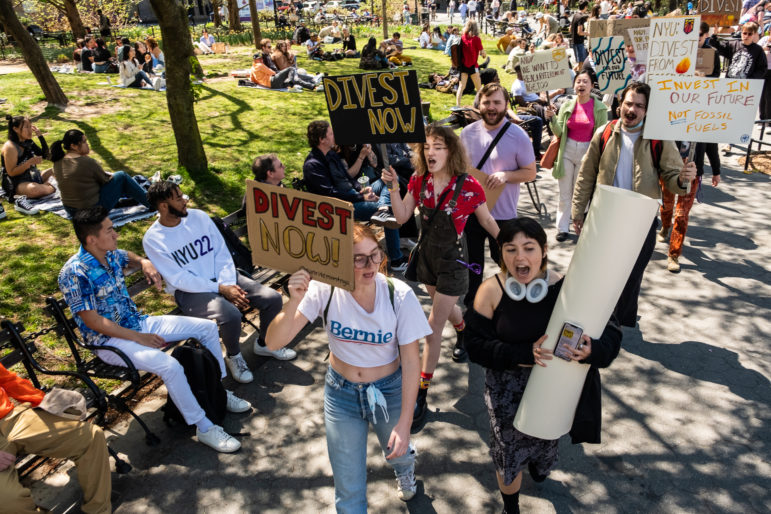As New York City continues to stagger under the burden of exporting 13,000 tons of household trash a day, the City Council Sanitation and Solid Waste Committee is prodding the Department of Sanitation to look to state-of-the-art technology for solutions.
But don’t call it incineration.
This summer, the Council plans to invite four “waste to energy” companies to a hearing, where they’ll showcase technologies that they want to put into operation in New York City.
“The new technology is a realistic option if the city wants it,” says Carmen Cognetta, legal counsel for the Sanitation and Solid Waste Committee. “But it’ll take some movement on the part of the mayor and the Sanitation Department to think beyond more than the next couple of years. It’ll be too late when the landfills are all full, and there’s no place to put the trash.”
The hottest proposals, literally, come from companies marketing super-heated zapping of trash. Unlike incinerators, which use combustion to break waste down into carbon dioxide and other gases, these waste-to-energy technologies attack trash at the molecular level, in an oxygen-starved environment. This breakdown, the companies claim, creates gas without the smoke, greenhouse gases and dioxins and other toxins that accompany combustion. As an additional benefit, the process produces energy–one company claims that it can turn 20 tons of trash per hour into 50 megawatts of power.
Startech Environmental Corp., one of the companies slated to testify, makes a machine that uses ion-charged plasma torches to zap trash with temperatures as high as 30,000 degrees Fahrenheit–three times hotter than the sun’s surface, and hot enough to break down the bonds between molecules. (When the plasma torch is lowered into the plasma converter chamber, it looks like a rocket ship coming in for a landing.) The gas from this process is then cleaned of metals, compressed and sent to a turbine where it can generate energy.
The company is handicapped by several factors, though, not least of which is its lack of a track record in the United States. The company’s biggest project in operation is a $2.4 million, five-ton-per-day plasma converter installed last November in Fukuoka, Japan. A second drawback is that its technologies work on a small scale: Its largest model can handle only 100 tons of trash per day.
Another company looking to do business with the city, D.C.-based Solena Group Inc., has likewise sold its technology in Europe and Asia, but never the United States. Like Startech, Solena uses plasma torches to break garbage down at the molecular level, a process the company says was developed by NASA scientists studying how spacecraft would react to extreme heat during reentry into the earth’s atmosphere. U.S. customers, whether municipalities or corporations, haven’t been forced to find alternatives to landfills, says Solena chief scientist Dennis Miller. “We’re selling plants faster than we can build them in Europe and Asia,” he says. “But in the U.S., we can’t compete with a hole in the ground.”
Solena and Startech claim that their plasma conversion processes are much cleaner than incineration, producing no ash and negligible amounts of nitrogen oxides and other harmful gases. The gases produced by the process are cooled, filtered and sent to an attached turbine to create energy. There’s no smoke stack. Particles not completely gasified by the process collect at the bottom of the plasma converter and are compressed as glassy black slag that can be cut into blocks and sold as building materials.
But because plasma conversion has never been put to the test in the U.S., environmental and community advocates in the city are deeply split on the technology, which Solena presented at a City Council hearing last June. Some community activists who opposed incineration welcome waste-to-energy as a benevolent alternative. Environmental groups say the proposed plants demand far greater scrutiny and are no substitute for policies promoting waste reduction and recycling.
Long opposed to incineration because of its smell and health hazards, Brooklyn residents Charles and Adeline Michaels are vocal supporters of waste-to-energy. “You could use the same infrastructure that’s already in place to handle waste, but you ultimately would be turning the trash into energy rather than burying it,” says Charles, a manager in the city’s Department of Information Technology and Telecommunications.
Adeline Michaels, president of Concerned Citizens of Bensonhurst and a member of Brooklyn’s Solid Waste Advisory Board, has been following the development of Solena’s technology since the mid-1990s, when the city, its solid waste advisory boards and the Environmental Protection Agency were investigating new ways of treating dredged material from New York Harbor. A staunch opponent of incineration–she fought to make sure the nearby Southwest Brooklyn Incinerator remained dormant–Michaels says it’s most important to understand that Solena’s conversion process doesn’t use oxygen. “People don’t understand how it works,” says Michaels. “They hear extreme heat, and they think fire.”
Truck traffic and pollution are other scourges some residents are hoping waste-to-energy could mitigate. “If the new technologies keep the trucks off residential roads, it’s good,” says retired sanitation worker Sal Cantelmi. “Using gas from the trash for energy is a step in the right direction.” Still, Cantelmi says he would want the city to discuss any decisions regarding new waste-to-energy technology before they installed a plant in his Greenpoint, Brooklyn, neighborhood. “The city would have to be prepared with safety reports or some other proof that the new technology isn’t going to create additional pollution,” he says.
Indeed, environmental groups caution against a rush to embrace waste-to-energy, especially since recycling and waste reduction have not fully been put in place as an alternative. “These technologies are unproven,” says Mark Izeman, senior attorney for the Natural Resources Defense Council. “Right now New York City has to find ways to deal with its garbage in a cost-effective and environmentally sound manner. These proposals don’t satisfy either.”
The city’s Department of Sanitation says it is open to the new technologies. The department has concerns, however, about any unproven system’s ability to handle trash on the scale of New York City’s. “Considering the enormity of the city’s waste production,” says John Pampalone, a Sanitation Department spokesman, “we don’t know of any plant in operation that can handle this efficiently.”
Solena’s Miller proposes that it’s just a matter of building enough facilities and placing them at existing waste transfer stations around the city. While acknowledging that investing in plant construction would be an expensive proposition for the city, waste-to-energy proponent Steven Cohen, who directs Columbia University’s graduate program in earth systems, science policy and management, says that the more formidable obstacle is a political one. “The companies can’t understand why New York wouldn’t buy their technology,” says Cohen. “They don’t understand the political barriers. People have a not-in-my-backyard syndrome. I know from our research that this is a proven technology all over the world.”
Larry Greenemeier is a Brooklyn-based journalist covering business and technology.








